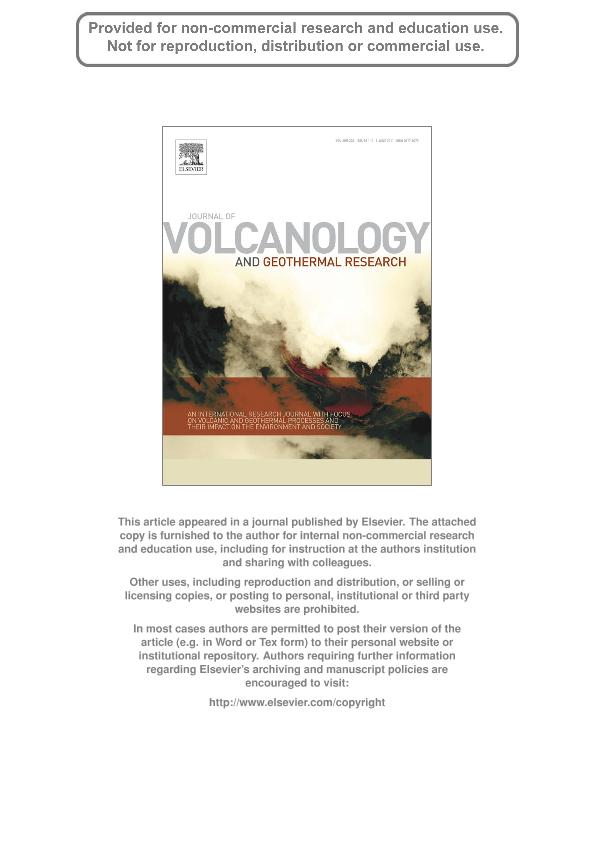Mostrar el registro sencillo del ítem
dc.contributor.author
Guido, Diego Martin

dc.contributor.author
Campbell, Kathleen A.
dc.date.available
2020-01-17T15:18:13Z
dc.date.issued
2011-06
dc.identifier.citation
Guido, Diego Martin; Campbell, Kathleen A.; Jurassic hot spring deposits of the Deseado Massif (Patagonia, Argentina): Characteristics and controls on regional distribution; Elsevier Science; Journal of Volcanology and Geothermal Research; 203; 1-2; 6-2011; 35-47
dc.identifier.issn
0377-0273
dc.identifier.uri
http://hdl.handle.net/11336/95055
dc.description.abstract
The Deseado Massif, Santa Cruz Province, Argentinean Patagonia, hosts numerous Middle to Late Jurassic age geothermal and epithermal features represented by siliceous and calcareous chemical precipitates from hot springs (sinters and travertines, respectively), hydrothermal breccias, quartz veins, and widespread hydrothermal silicification. They indicate pauses in explosive volcanic activity, marking the final stages in the evolution of an extensive Jurassic (ca. 178–151 Ma) volcanic complex set in a diffuse extensional back-arc setting heralding the opening of the Atlantic Ocean. Published paleo-hot spring sites for the Deseado Massif, plus additional sites identified during our recent field studies, reveal a total of 23 locations, five of which were studied in detail to determine their geologic and facies associations. They show structural, lithologic, textural and biotic similarities with Miocene to Recent hot spring systems from the Taupo and Coromandel volcanic zones, New Zealand, as well as with modern examples from Yellowstone National Park, U.S.A. These comparisons aid in the definition of facies assemblages for Deseado Massif deposits – proximal, middle apron and distal siliceous sinter and travertine terraces and mounds, with preservation of many types of stromatolitic fabrics – that likely were controlled by formation temperature, pH, hydrodynamics and fluid compositions. Locally the mapped hot spring deposits largely occur in association with reworked volcaniclastic lacustrine and/or fluvial sediments, silicic to intermediate lava domes, and hydrothermal mineralization, all of which are related to local and regional structural lineaments. Moreover, the numerous geothermal and significant epithermal (those with published minable resources) deposits of the Deseado Massif geological province mostly occur in four regional NNW and WNW hydrothermal–structural belts (Northwestern, Northern, Central, and Southern), defined here by alignment of five or more hot spring deposits and confirmed as structurally controlled by aeromagnetic data. The Northern and Northwestern belts, in particular, concentrate most of the geothermal and epithermal occurrences. Hence, Jurassic hydrothermal fluid flow was strongly influenced by the most dominant and long-active geological boundaries in the region, the outer limits of the Deseado Massif ‘horst’ itself.
dc.format
application/pdf
dc.language.iso
eng
dc.publisher
Elsevier Science

dc.rights
info:eu-repo/semantics/openAccess
dc.rights.uri
https://creativecommons.org/licenses/by-nc-sa/2.5/ar/
dc.subject
Deseado Massif
dc.subject
Patagonia
dc.subject
Jurassic Hot Spring
dc.subject
Facies Analysis
dc.subject
Regional Faults
dc.subject
Epithermal
dc.subject.classification
Geología

dc.subject.classification
Ciencias de la Tierra y relacionadas con el Medio Ambiente

dc.subject.classification
CIENCIAS NATURALES Y EXACTAS

dc.title
Jurassic hot spring deposits of the Deseado Massif (Patagonia, Argentina): Characteristics and controls on regional distribution
dc.type
info:eu-repo/semantics/article
dc.type
info:ar-repo/semantics/artículo
dc.type
info:eu-repo/semantics/publishedVersion
dc.date.updated
2020-01-15T20:05:54Z
dc.journal.volume
203
dc.journal.number
1-2
dc.journal.pagination
35-47
dc.journal.pais
Países Bajos

dc.journal.ciudad
Amsterdam
dc.description.fil
Fil: Guido, Diego Martin. Consejo Nacional de Investigaciones Científicas y Técnicas; Argentina. Universidad Nacional de La Plata. Facultad de Ciencias Naturales y Museo. Instituto de Recursos Minerales. Provincia de Buenos Aires. Gobernación. Comisión de Investigaciones Científicas. Instituto de Recursos Minerales; Argentina
dc.description.fil
Fil: Campbell, Kathleen A.. University of Auckland; Nueva Zelanda
dc.journal.title
Journal of Volcanology and Geothermal Research

dc.relation.alternativeid
info:eu-repo/semantics/altIdentifier/url/https://www.sciencedirect.com/science/article/pii/S0377027311000837
dc.relation.alternativeid
info:eu-repo/semantics/altIdentifier/doi/http://dx.doi.org/10.1016/j.jvolgeores.2011.04.001
Archivos asociados
